Vat Phou Temple - The Remnant of Khmer Empire in Laos
by Seni World May 14, 2023
Khmer architecture has become a part of Laos since the land of million elephants once was the part of Khmer Empire. Therefore, when listing tourist hubs in Laos, you could not ignore Vat Phou Temple whose history is believed to be longer than Angkor Wat in Cambodia. It is considered as the milestone of an empire and is a remarkable religious monument in its country.
History and Significant Values of Vat Phou Temple
Vat Phou complex, which was destroyed seriously, is located in Champasak Plains on the banks of Mekong River. No one can make sure whether Champasak was the part of Champa or Chenla Kingdom, but the first imprint in this area was left by the Khmer who were believed to own the highly sophisticated culture. The oldest part in the complex is likely to date back to fifth or sixth century and some others were built in 10th or 11th century. It once was known as the Hinduism site since its natural purpose was to dedicate to Shiva – one of the principal deities of Hinduism. However, as time passed by, it was changed to worship Buddha.
Vat Phou temple was erected at the foot of Phou Kao Mountain which was known as Lingapar or Linga Mountain in Sanskrit under the reign of Jayavarman I. This mountain got this name because its peak is seen to resemble the linga of god Shiva.
With the value in term of history and culture, Vat Phou temple was declared as World heritage site by UNESCO in 2001.
Masterful Architecture of Vat Phou Temple
Lower Level
Located in the large plain, the ruin complex seems to hold the secrets of the ancient world. The scared site was first built to express the harmony of man and nature in Hindu vision. Thus, there’s no doubt that you will have the mystical feeling when you first capture the image of landscape. Like other particular Khmer structures, Vat Phou is oriented by the west-east axis and also refers to the mythology of God’s home with the artificial lake representing the ocean and Phou Kao Mountain representing Meru Mount, where Gods live. The entrance behind the large baray is not in the original shape, we just see the foundation of the sandstone gateway.
Middle Level
The “ancient road” leading to the middle level is ornamented with the line of stunning engraving sandstone posts and two large barays on two sideways.
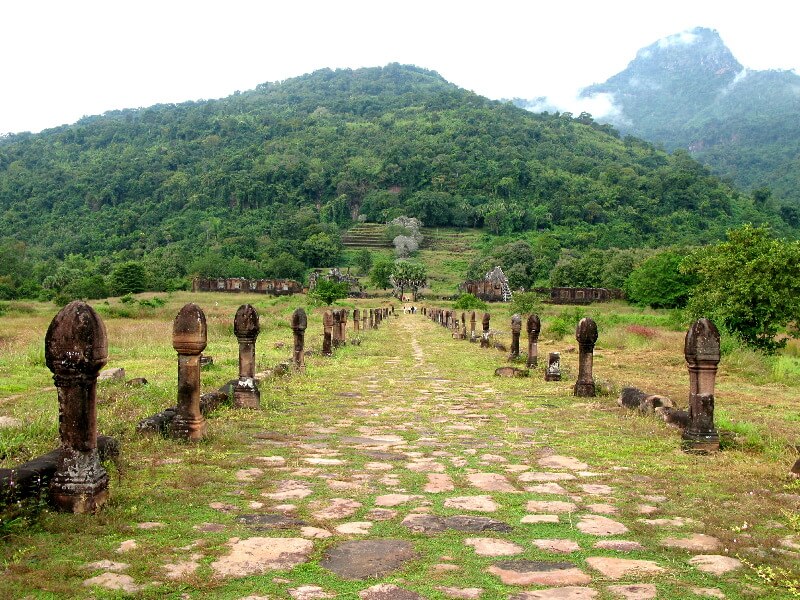
The end of the road is marked by two longstanding buildings. Each pavilions which was built of stone and laterite with a central courtyard stands on a side of the road. Besides the religious function, these rectangular structures are believed to be the accommodation for men and women respectively. Thus, they are known as “men’s palace” and “women’s palace” or the North Palace and the South Palace.
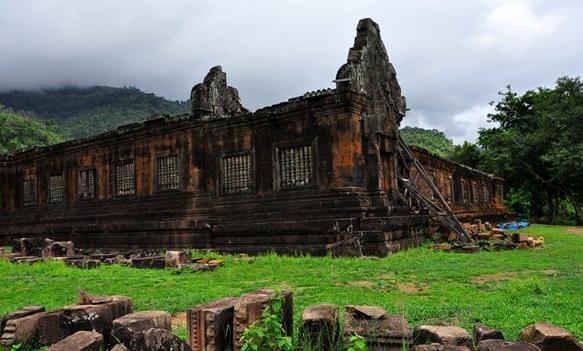
Not far the building in the south is the small shrine which was used to worship Nandi – the bull that served as the Shiva’s mount. Like some other part in Vat Phou, due to of war and weather this shrine was destroyed seriously and now it is under the reconstruction. This shine once was the starting point of the road leading to Angkor Wat in Cambodia.
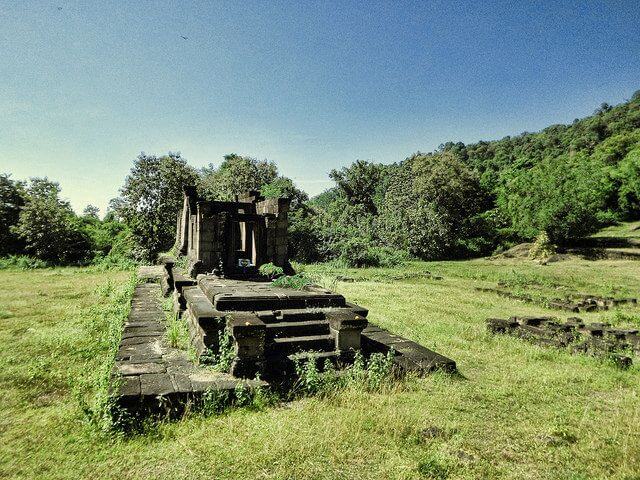
Passing the causeway which were flanked by collapsed buildings and the stone staircases, visitors can meet the some inpressive stone carvings such as the holy dvarapala with sword, pedestal, the unusual dvarapala statues half-buried in the grass. Moreover, the six ruined shrines also lie in this area.

Upper Level
The main sanctuary is located in the upper level of the complex. After crossing the stairs and road covered by stone and shade of green trees, visitors can find a ruin temple with three doors.
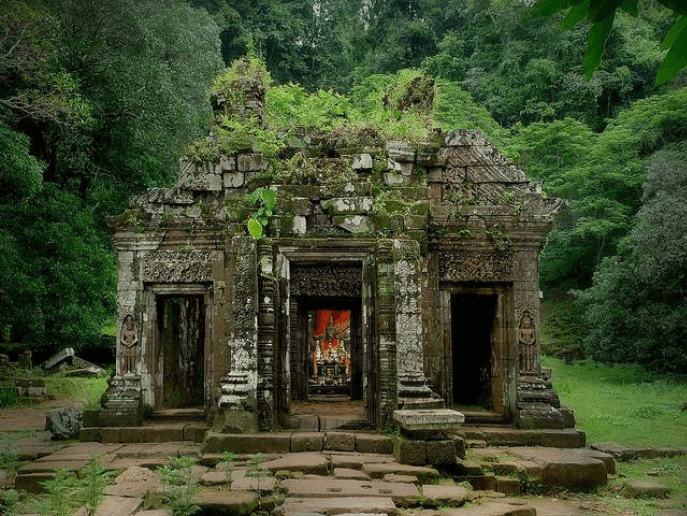
It is adored with many elaborate carving which mainly reflect the relief of Hindu. One of impressive part is the intricate craftsmanship carving in lintel of the doorway. In the main room of temple is a altar with an old, distinctive, gold Buddha statue.
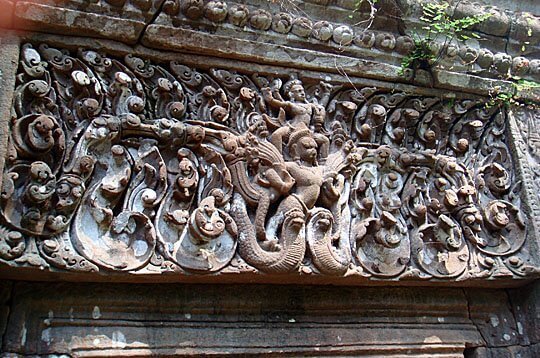
In the south of the santuary is a in poor condition library and the large boulder behind the sanctuary scultped Trimurti which is the triad of three gods Brahma, Vishnu and Shiva. Moreover, not far from the main temple, visitors can find the mess rocks which carved the elephants, crocodile or even contain the Buddha footprint. Another of special feature of this area is the holy spring flowing from a cave not far from the Trimurti.
.jpg)
Scared Festival
With highly religious value, the Vat Phou festival is of importance event in the country. It was held on three days and occurs at the end of January or early February. It offers visitors the chance to enjoy the pray ceremonies, sport competitions and local dance performance.

» Discover Laos in luxury ways with Laos River Cruises» Contact us today and get best offer for your expedition


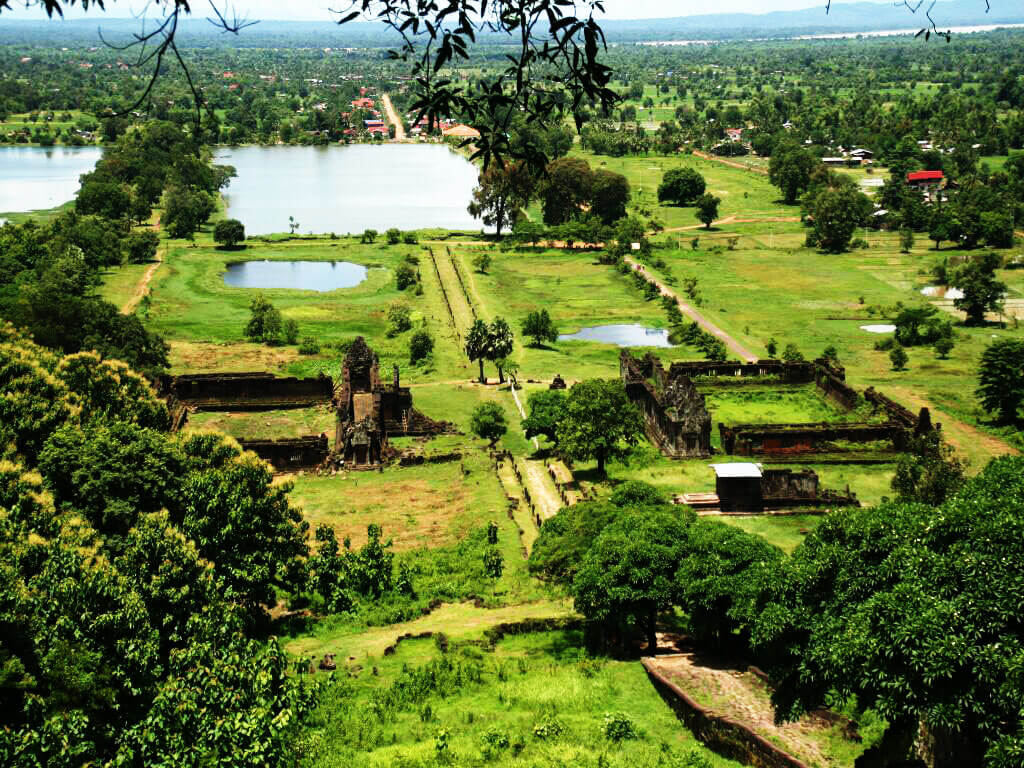







![[Must Read] The Best Time for A Cruise on Mekong River [Must Read] The Best Time for A Cruise on Mekong River](https://topmekongcruises.com/thumb/crop/1188/90/90)


































